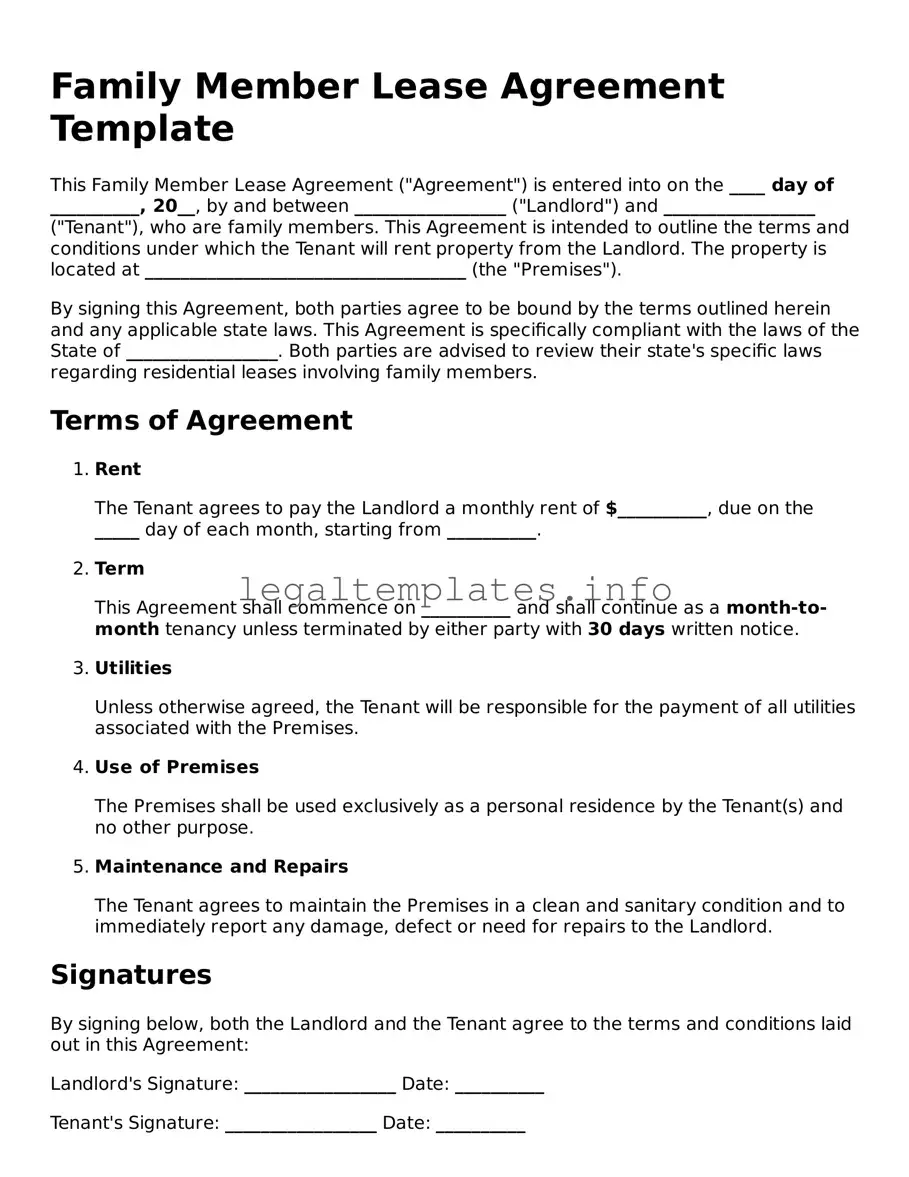The Family Member Lease Agreement form shares similarities with a Standard Residential Lease Agreement, which outlines the terms and conditions under which a tenant agrees to rent property from a landlord. Both documents specify the duration of the lease, rent amount, and other conditions such as maintenance responsibilities and rules about pets. The primary difference lies in the relationship between the parties; family member lease agreements are specifically between relatives, possibly allowing for more flexible terms.
Another related document is the Month-to-Month Rental Agreement, which provides for a rental arrangement that can be terminated or altered by either party with proper notice, typically 30 days. Like the Family Member Lease Agreement, this flexibility is key, offering both parties the ability to adjust terms without the commitment to a long-term lease. However, the family agreement may include clauses tailored to the nuances of familial relationships.
The Roommate Agreement is also akin to the Family Member Lease Agreement, in that both deal with living arrangements and specify terms regarding rent, utility payments, and shared responsibilities. However, the Roommate Agreement is between individuals who may not have a familial connection, focusing more on cohabitation logistics than the relational dynamics addressed in family-specific leases.
Sublease Agreements have similarities to the Family Member Lease Agreement too, allowing a tenant to rent out their space to someone else. This involves the original tenant, a subtenant, and often requires landlord approval. The family member lease might function similarly if a family member is stepping into an existing lease arrangement, but typically, these family agreements are more direct, without involving a third-party tenant.
The Rent-to-Own Lease Agreement, which combines rental and purchase agreements, providing tenants the option to buy the rental property, parallels the Family Member Lease Agreement in its potential for long-term planning within the family. Both may facilitate eventual ownership or permanent living arrangements, but the rent-to-own specifically includes terms for purchase that are not inherent in the family lease.
A Property Management Agreement could also be comparable, particularly in scenarios where a family member acts as a property manager for the dwelling another family member is leasing. This agreement outlines the responsibilities of managing the property, similar to some aspects of the Family Member Lease Agreement that might delegate maintenance or other tasks. However, it's more about operational roles than rental terms.
The Vacation Rental Short Term Lease Agreement is yet another document that shares characteristics with the Family Member Lease Agreement, especially in the context of short-term stays. Both outline use terms for a property over a brief period, but family agreements may not adhere strictly to a vacation or short-term focus, often encompassing more permanent arrangements.
Lease Renewal Agreements, which extend the term of an existing lease under similar conditions, also bear resemblance. These are especially relevant if family members decide to extend their living arrangement beyond the initial term agreed upon. While the renewal is more of a continuation than an initial agreement setup, the principle of agreeing on terms for continued occupancy is shared.
Finally, the Commercial Lease Agreement, while primarily for business properties, can intersect with the Family Member Lease Agreement when renting involves commercial spaces owned within a family. Both agreements dictate terms for property use, though the commercial lease is tailored to business purposes and may include specific clauses about commercial activities, zoning, and signage that are not typically relevant in a family living situation.
